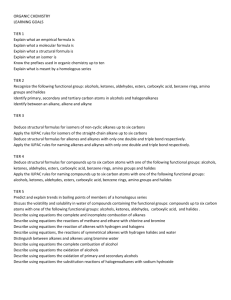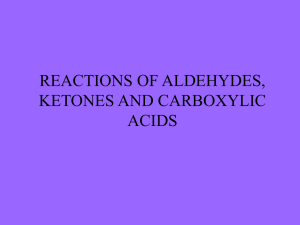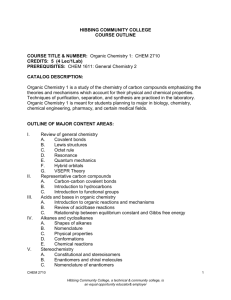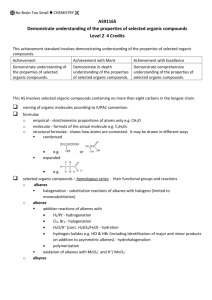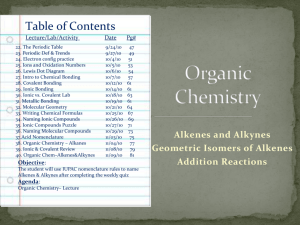CHEM2010 - Organic Chemistry I
advertisement
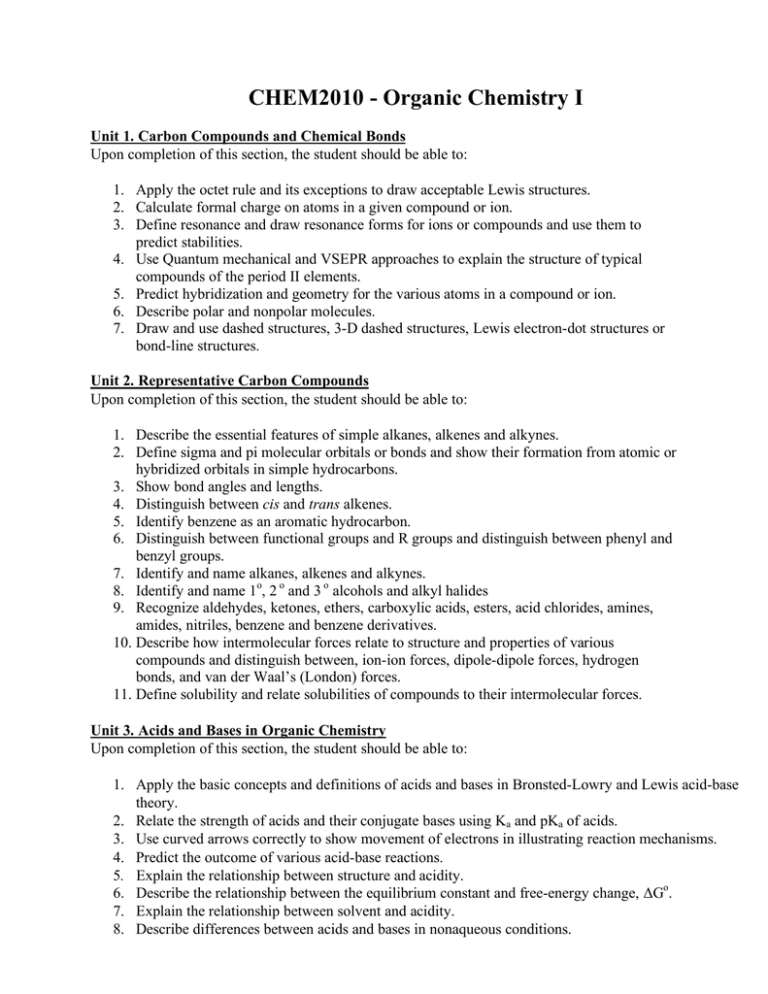
CHEM2010 - Organic Chemistry I Unit 1. Carbon Compounds and Chemical Bonds Upon completion of this section, the student should be able to: 1. Apply the octet rule and its exceptions to draw acceptable Lewis structures. 2. Calculate formal charge on atoms in a given compound or ion. 3. Define resonance and draw resonance forms for ions or compounds and use them to predict stabilities. 4. Use Quantum mechanical and VSEPR approaches to explain the structure of typical compounds of the period II elements. 5. Predict hybridization and geometry for the various atoms in a compound or ion. 6. Describe polar and nonpolar molecules. 7. Draw and use dashed structures, 3-D dashed structures, Lewis electron-dot structures or bond-line structures. Unit 2. Representative Carbon Compounds Upon completion of this section, the student should be able to: 1. Describe the essential features of simple alkanes, alkenes and alkynes. 2. Define sigma and pi molecular orbitals or bonds and show their formation from atomic or hybridized orbitals in simple hydrocarbons. 3. Show bond angles and lengths. 4. Distinguish between cis and trans alkenes. 5. Identify benzene as an aromatic hydrocarbon. 6. Distinguish between functional groups and R groups and distinguish between phenyl and benzyl groups. 7. Identify and name alkanes, alkenes and alkynes. 8. Identify and name 1o, 2 o and 3 o alcohols and alkyl halides 9. Recognize aldehydes, ketones, ethers, carboxylic acids, esters, acid chlorides, amines, amides, nitriles, benzene and benzene derivatives. 10. Describe how intermolecular forces relate to structure and properties of various compounds and distinguish between, ion-ion forces, dipole-dipole forces, hydrogen bonds, and van der Waal’s (London) forces. 11. Define solubility and relate solubilities of compounds to their intermolecular forces. Unit 3. Acids and Bases in Organic Chemistry Upon completion of this section, the student should be able to: 1. Apply the basic concepts and definitions of acids and bases in Bronsted-Lowry and Lewis acid-base theory. 2. Relate the strength of acids and their conjugate bases using Ka and pKa of acids. 3. Use curved arrows correctly to show movement of electrons in illustrating reaction mechanisms. 4. Predict the outcome of various acid-base reactions. 5. Explain the relationship between structure and acidity. 6. Describe the relationship between the equilibrium constant and free-energy change, ΔGo. 7. Explain the relationship between solvent and acidity. 8. Describe differences between acids and bases in nonaqueous conditions. Unit 4. Alkanes and Cycloalkanes. Conformations of Molecules Upon completion of this section, the student should be able to: 1. Describe the general features, sources and general physical properties of alkanes and cycloalkanes. 2. Use IUPAC nomenclature to name alkanes of up to twenty carbons and with alkyl groups containing at least four carbons. Be able to classify carbons and their attached hydrogens as 1o, 2o, and 3o. 3. Name common alkyl halides and alcohols with at least six carbons. 4. Classify alcohols and alkyl halides as 1o, 2o, or 3o. 5. Use systematic names for cycloalkanes. 6. Describe how sigma bonds are involved in bond rotation. 7. Describe the conformational analysis of butane and show or identify the syn or anti conformers of butane. 8. Describe the differences in stabilities of cycloalkanes of up to eight carbons. 9. Describe the components of ring strain: angle strain and torsional strain. 10. Review the conformations of cyclohexane and compare the relative stabilities of the various conformers. 11. Draw the boat and chair conformers of cyclohexane and identify the axial and equatorial positions. 12. Name various isomers of disubstituted cyclohexane and draw or identify various cis or trans isomers of disubstituted cycloalkanes. 13. Give systematic names for various bicycloalkanes of up to ten carbons including those with alkyl substituents. 14. Indicate that combustion and halogenation are the major reactions of alkanes 15. Understand that alkanes can be produced by the catalytic reduction of alkenes and the reduction of alkyl halides and write equations or complete equations for these reaction types. 16. Describe the retrosynthetic approach to organic synthesis. Unit 5. Chiral Molecules and Stereochemistry Upon completion of this section, the student should be able to: 1. Describe chirality and distinguish between constitutional isomers and stereoisomers, as well as enantiomers and diastereomers. 2. Identify planes of symmetry within molecules. 3. Name compounds with one or two stereocenter carbon atoms using the R-S nomenclature system as determined using the rules of the Cahn-Ingold-Prelog convention. 4. Describe the origin of optical activity, the general features of a polarimeter, the measurement of optical activity and define specific rotation and optical purity. 5. Define and distinguish between racemic mixtures and meso compounds and describe how racemic mixtures can be resolved. 6. Distinguish between relative and absolute configuration. 7. Use and draw Fischer projection formulas. 8. Recognize compounds such as allenes which are optically active but which do not possess a tetrahedral atom with four different groups. Unit 6. Ionic Reactions-Nucleophilic Substitution and Elimination Reactions of Alkvl Halides Upon completion of this section, the student should be able to: 1. Define organohalogens or alkyl halides and describe their general physical properties and compare them to hydrocarbons. 2. Distinguish between homolysis and heterolysis and the characteristics of a carbocation, a carbanion and a radical. 3. Identify the nucleophile, substrate, product and leaving group in a nucleophilic substitution reaction and relate the properties of a good nucleophile or leaving group. 4. Describe the kinetics of bimolecular nucleophilic substitution (SN2) reactions using examples such as the reaction of hydroxide ion with methyl chloride in aqueous solution. 5. Describe a proposed SN2 mechanism and discuss how it relates to stereochemistry. Also, discuss the transition state theory for the mechanism. 6. Describe the kinetics of a unimolecular nucleophilic substitution (SN1) reaction using an example such as the solvolysis of tert-butyl chloride. 7. Describe a proposed SN1 mechanism and discuss the transition state theory for the mechanism. 8. Detail the structure and order of stability of various alkyl carbocations and their stereochemistry. 9. Describe how the relative rates of SN1 and SN2 substitution mechanisms are affected by: the substrate structure, the concentration and reactivity of the nucleophile, the solvent, and the nature of leaving group. 10. Identify which mechanism is most favored by polar aprotic solvents and give an explanation. 11. Define dehydrohalogenation, list bases commonly used in dehydrohalogenation and write equations for this type of reaction. 12. Differentiate between E1 and E2 reactions and show their mechanisms. 13. Recognize temperature as the major factor controlling the competition between elimination and substitution reactions and relate the structure of the alkyl halide and the base to the competition between substitution and elimination. Unit 7. Radical Reactions Upon completion of this section, the student should be able to: 1. Use barbed or fishhook arrows to show formation of radicals by homolytic cleavage of the covalent bond. 2. Relate the homolytic bond dissociation energies to the relative stabilities of methyl, 1°, 2° or 3° radicals. 3. Explain the three step mechanism (initiation, propagation and termination) for the chlorination of methane and use this mechanism for the reaction of methane with other halogens. 4. Use the general mechanism for the halogenation of higher alkanes. 5. Relate the high reactivity of fluorine and the lack of reactivity of iodine to the energy changes associated with each step of the mechanism for halogenation and explain the selectivity of bromine by use of the Hammond-Leffler postulate Unit 8. Alkenes and Alkynes I. Properties And Synthesis Upon completion of this section, the student should be able to: 1. Give the IUPAC name or structure for various assigned alkenes, cycloalkenes and alkynes and use both cis-trans and (E)-(Z) names for alkenes. 2. Describe general physical properties of alkenes and alkynes. 3. Describe the function of a catalyst in hydrogenation of alkenes and distinguish between syn and anti addition. 4. Describe the conditions needed to give syn addition of hydrogen to alkynes to produce cis-alkenes and the conditions needed to give anti addition to alkynes to produce trans-alkenes. 5. Describe how hydrogenation and combustion analysis can show the relative stabilities of alkenes and show the correct order of stability for substituted alkenes. 6. Account for the formation of both Saytzeff (Zaitsev) and Hofmann products by the E2 dehydrohalogenation of alkyl halides, show the stereochemistry of anti periplanar elimination and account for the major and minor products formed from various primary, secondary and tertiary alkyl halides. 7. Discuss the Whitmore mechanism for the E1 dehydration of alcohols to form alkenes. 8. Give the correct order of stability for carbocations and show how carbocations may rearrange by hydride or methanide transfers to produce the most stable carbocation and the corresponding rearranged products. 9. Distinguish between the conditions needed to produce alkenes from vicinal dibromides and the conditions needed to produce alkynes from vicinal dibromides. 10. Compare the acidity of terminal alkynes, alkenes and alkanes. 11. Explain the preparation of sodium alkynides from terminal alkynes and the syntheses of other alkynes by reaction of alkynides with primary alkyl halides. Unit 9. Alkenes and Alkynes II. Addition Reactions Upon completion of this section, the student should be able to: 1. Indicate general considerations for electrophilic addition to alkenes, state Markovnikov’s rule for the addition of hydrogen halides to alkenes, describe how the modern ionic addition mechanism explains Markovnikov’s rule and define the term “regioselective reaction”. 2. Compare the addition of sulfuric acid to alkenes and the acid catalyzed hydration of alkenes. 3. Indicate the conditions under which bromine and chlorine add to alkenes. 4. Describe the stereochemistry of electrophilic addition and show the formation of halohydrins in aqueous solutions of chlorine or bromine. 5. Describe the anti-Markovnikov hydrobromination of alkenes in the presence of peroxides. 6. Describe syn hydroxylation of alkenes by cold permanganate solutions or osmium tetroxide. 7. Describe the oxidative cleavage of alkenes with hot concentrated permanganate solutions and by ozonolysis. 8. Describe the similarity between addition of bromine, chlorine and hydrogen halides to alkynes and alkenes. 9. Describe how basic permanganate or ozone can cleave alkynes. 10. Describe the use of oxymercuration-demercuration to produce alcohols from alkenes without rearrangements. 11. Describe the production of organoboranes from hydroboration of alkenes and discuss the oxidation of organoboranes to produce alcohols and show the mechanisms of these reactions. 12. Describe the oxidation of alkenes by peroxyacids to give epoxides (oxiranes) with retention of cistrans configuration. Unit 10. Alcohols Upon completion of this section, the student should be able to: 1. Give IUPAC or common names for selected alcohols or draw structures from names. 2. Relate physical properties of alcohols to structure and describe significant properties of simple alcohols and diols. 3. Describe the use of LiA1H4, NaBH4 and Raney nickel to reduce various carbonyl compounds to give alcohols. 4. Describe the preparation of organolithium compounds and Grignard reagents and show the reaction of these reagents with compounds containing acidic hydrogens. 5. Describe the reactions of Grignard and organolithium reagents with ethylene oxide, formaldehyde, higher aldehydes, ketones, acid chlorides and esters to produce various alcohols. 6. Design a Grignard synthesis and describe the restrictions that apply to Grignard syntheses. CHEM2020 - Organic Chemistry II Unit 1. Reactions of Alcohols Upon completion of this section, the student should be able to: 1. Discuss the oxidation scale of organic compounds. Define oxidation and reduction of organic compounds. Be able to determine the oxidation state of a carbon atom based on the bonding. 2. Show how oxidation of primary alcohols to aldehydes can be accomplished by distillation from chromic acid solutions or with pyridinium chlorochromate 3. Show how aldehydes may be oxidized to acids. 4. Show the mechanism for the chromate oxidations of primary or secondary alcohols to aldehydes or ketones. 5. Show examples of mesylates and tosylates used in SN2 reactions. 6. Show the preparation of alkyl halides from alcohols by the reaction with hydrohalic acids, PBr3 or SOC12 Unit 2. Preparation and Reactions of Ethers Upon completion of this section the student should be able to: 1. 2. 3. 4. Show the formation of ethers by intermolecular dehydration of alcohols. Show the Williamson synthesis of ethers from alkyl halides, alkyl sulfonates or alkyl sulfates. Show the alkylation of alcohols to produce tert-butyl ethers. Show the cleavage of ethers by HBr. Unit 3. Conjugated Unsaturated Systems Upon completion of this section the student should be able to: 1. Show the mechanism for the free radical allylic substitution, relate the stability of the allyl radical and allylic radicals to other radicals and show allylic bromination with N-bromosuccinimide. 2. Show the relative order of stability of allylic and allyl carbocations compared to the common alkyl carbocations. 3. Discuss and apply the summary rules for resonance structures. Be able to estimate the relative stability of resonance structures. 4. Identify various alkadienes and polyunsaturated hydrocarbons, differentiate between conjugated and isolated dienes, distinguish between s-cis and s-trans conformations for 1,3-butadiene and show how bond distances are affected in conjugated dienes. 5. Identify factors that control 1,2 or 1,4 addition to conjugated dienes (rate control vs. equilibrium control) and identify the type of intermediate formed. 6. Show product formation in Diels-Alder reactions. Unit 4. Aromatic Compounds Upon completion of this section the student should be able to: 1. Describe physical and chemical properties and the modern structure of benzene. 2. Recognize the similarities and differences of the reactions of simple alkenes, benzene and a complex polyene such as 1,3,5,7-cyclooctatetraene. 3. Realize the significance of the resonance energy of benzene. 4. Describe the pros and cons of Huckel’s Rule and apply it to benzene and benzene-like compounds as well as annulene and annulene-like compounds. 5. Recognize the two types of aromatic ions, anionic and cationic. 6. Look at structure of benzenoid compounds and predict if they would be aromatic or not. 7. Name benzene derivatives: A. Monosubstituted benzene i. Benzene as parental name with substituent having a normal prefix ii. New base name depending on the substituent giving rise to common and trivial names. B. Disubstituted benzene i. ortho ii. meta iii. para iv. trivial names depending on substituent present C. Polysubstituted benzene i. Normal ii. Trivial D. Use of phenyl as a group name E. Use of benzyl as a group name F. Use of benzal as a group name G. Use of benzo as a group name Unit 5. Electrophilic and Nucleophilic Aromatic Substitution Upon completion of this section, students should be able to: 1. Show the preparation of mono-substituted benzenes such as: A. Nitrobenzene B. Bromobenzene C. Chlorobenzene D. Benzene sulfonic acid E. Alkylbenzene F. Aryl-aliphatic ketones 2. Write the mechanism of benzene substitution. 3. Discuss the directive influence of first substituent on the benzene ring. 4. Discuss the activation or deactivation of the benzene ring for further substitution. 5. Discuss relative rate of reaction of substituent. 6. Prepare di, tri, and tetra-substituted benzenes, and explain the rules of synthesis 7. Write structures of naphthalene and anthracene. 8. Discuss chlorination of side chain group on ring compared to ring substitution 9. Write equations for oxidation of alkyl side chains. 10. Write equations for reactions of alkenyl side chains toward addition. 11. Write equations for Friedel-Craft reaction. 12. Write equations for nitric acid oxidation of -OH group of phenols and -NH2 group of amines. 13. Discuss and write equations for alternate preparation methods designed to protect groups already on the ring that are subject to oxidation. 14. Prepare benzenediazonium chloride and reactions with Cu2C12, Cu2Br2, CuCN, H3PO2, H2O, NaBF4, and KI 15. Name phenols using the IUPAC systematic names as well as the common names 16. Distinguish the chemical properties of phenols from alcohols 17. Compare the acidity of various phenols 18. Discuss with an equation the reaction of phenols with a base like NaOH and Na2CO3 19. Write reactions for formation of aryl-alkyl ethers by Williamson synthesis 20. Write reactions for synthesis of salicylic acid by carboxylation of phenol 21. Write reactions for oxidation of phenols to quinones Unit 6. Aldehydes And Ketones Upon completion of this section, students should be able to: 1. 2. 3. 4. Recognize aldehydes and ketones by their common names and IUPAC names. Explain the structure of the carbonyl group. Recognize and interpret molecular spectra of aldehydes and ketones. Write the reactions for the synthesis of: (a) carbonyl compounds from oxidation of alcohols (b) carbonyl compounds from ozonolysis of alkenes (c) carbonyl compounds from Friedel-Crafts acylation (d) carbonyl compounds from hydration of alkynes (e) carbonyl compounds from 1 ,3-dithianes (f) ketones from carboxylic acids (g) ketones from nitriles (h) aldehydes from acid chlorides 5. Discuss the following reactions of ketones and aldehydes: (a) nucleophilic addition of carbanions and hydride reagents (b) nucleophilic addition of water (c) nucleophilic addition of hydrogen cyanide (d) nucleophilic addition of alcohols (e) condensation with ammonia and primary amines (f) condensation with hydroxylamine and hydrazines 6. Write equations for oxidation of aldehydes and ketones 7. Write equations for reduction of aldehydes and ketones Unit 7 Amines Upon completion of this section, students should be able to: 1. 2. 3. 4. 5. 6. Name amines using the IUPAC systematic names as well as the common names Distinguish between a primary, secondary and a tertiary amine Discuss the chirality of amines and quaternary ammonium ions Distinguish between aliphatic and aromatic amines Compare the basicity of various amines Write the reactions for the synthesis of amines by: (a). alkylation of ammonia and amines, (b). alkylation of azide ion 7. Discuss the reaction between nitrous acid and the different types of amines 8. Write reactions to illustrate Hofmann elimination of quaternary ammonium hydroxide to alkene. 9. Explain Hofmann’s rule for elimination of quaternary ammonium hydroxide. Unit 8. Carboxylic Acids and Their Derivatives; Nucleophilic Substitution at the Acyl Carbon Upon completion of this section, students should be able to: 1. Recognize carboxylic acids by common names and names according to IUPAC rules. 2. Explain the origin of acidity of carboxylic acids by Lowry Bronsted theory. 3. Explain the relative stability of the carboxylic acids and their anions (carboxylate ions) from the resonance structures of the former and latter. 4. Write the reactions for the formation of carboxylic acids from (a) oxidation of alkenes, aldehydes, and primary alcohols, (b) carbonation of Grignard reagents (c) acid chlorides, d) acid anhydrides (e) esters (f) amides (g) nitriles (h) cyanohydrins 5. Write reactions for the preparation of aromatic carboxylic acids by oxidation of alkylbenzenes 6. Name dicarboxylic acids by common naming and IUPAC rules. 7. Discuss the following reactions of carboxylic acids (a) as acids (b) reduction with LiA1H4 (c) conversion to acyl chlorides using reagents like SOC12, Pd3, and PC15 (d) conversion to anhydride, ester, lactones, amides, imides and lactams. (e) α-hydrogenation and decarboxylation 8. Name acyl halides, acid anhydrides, esters and amides 9. Identity most common acyl halides, acid anhydrides, esters, and amides from common names and IUPAC names Unit 9. Synthesis and Reactions of -Dicarbonyl Compounds Upon completion of this section, students should be able to: 1. Explain the origin of acidity of the α-hydrogen of a carbonyl compound compared to H-atoms attached to carbon atoms of other organic compounds. 2. Explain the resonance stabilization of enolate anions 3. Describe the equilibrium involving keto and enol forms of the carboxyl compounds. 4. Describe qualitatively the relative stability of keto and enol forms of carboxyl compounds. 5. Explain racemization of (+) sec-butyl phenyl ketone in acidic and basic medium via enolization. 6. Explain α -halogenation of ketones based on the formation of enolate ion. 7. Explain haloform reaction on the basis of enolization. 8. Explain iodoform test. 9. Describe aldol reaction, crossed aldol reaction and reversibility of aldol reactions. 10. Describe dehydration of the aldol condensation products. 11. Explain Claisen-Schmidt reactions. 12. Discuss the condensation with nitroalkanes and nitriles. 13. Discuss the synthetic applications of aldol condensation cyclizations via aldol condensations. 14. Discuss acid catalyzed aldol condensations 15. Discuss additions to c4~-unsaturated aldehydes and ketones. 16. Explain Michael additions. Unit 10. Carbohydrates Upon completion of this section, students should be able to: 1. 2. 3. 4. 5. 6. 7. Explain the meaning of the designation D and L as used to specify configuration of carbohydrates Classify monosaccharides using the designation D/L and aldose/ketone. Writer Fischer projections for the monosaccharides Draw Haworth projections and chair conformations for cyclic monosaccharides Explain the phenomenon of mutarotation with reference to carbohydrates Explain how mutarotation is detected Write equations for the following reactions of monosaccharides: (a) Formation of glycosides (acetals) (b) Formation of methyl ethers (c) Reduction with NaBH4 (d) Oxidation of monosaccharides (e) Reaction of glucose with primary aliphatic and aromatic amines. 8. Discuss the method used in assay of glucose. 9. Distinguish between disaccharides, oligosaccharides and polysaccharides. 10. Draw chair conformations for a given disaccharide. Unit 11. Lipids Upon completion of this section, students should be able to: 1. 2. 3. 4. 5. 6. Recognize the class of compounds called lipids. Write the reactions for saponification of fats and oils Explain the formation of micelles from soap. Explain the terms ‘emulsion’ and ‘emulsification’. Classify lipids into various categories, like triglycerides, steroids, phospholipids, terpenes, etc. Write the structures of various classes of lipids. Unit 12. Amino Acids and Proteins Upon completion of this section, students should be able to: 1. Describe the different types of amino acids. 2. List the essential amino acids. 3. Describe the preparation of amino acids 4. Discuss the acid-base nature of amino acids 5. Discuss the methods used in analysis of amino acids. 6. Write structures of some lactams and peptides. 7. Describe the analysis of peptides. 8. Discuss the syntheses of peptides. 9. Describe the structure of proteins. 10. Discuss the classification of proteins. 11. Discuss the biological functions of proteins and amino acids 12. Discuss the basic structure of DNA and RNA.

